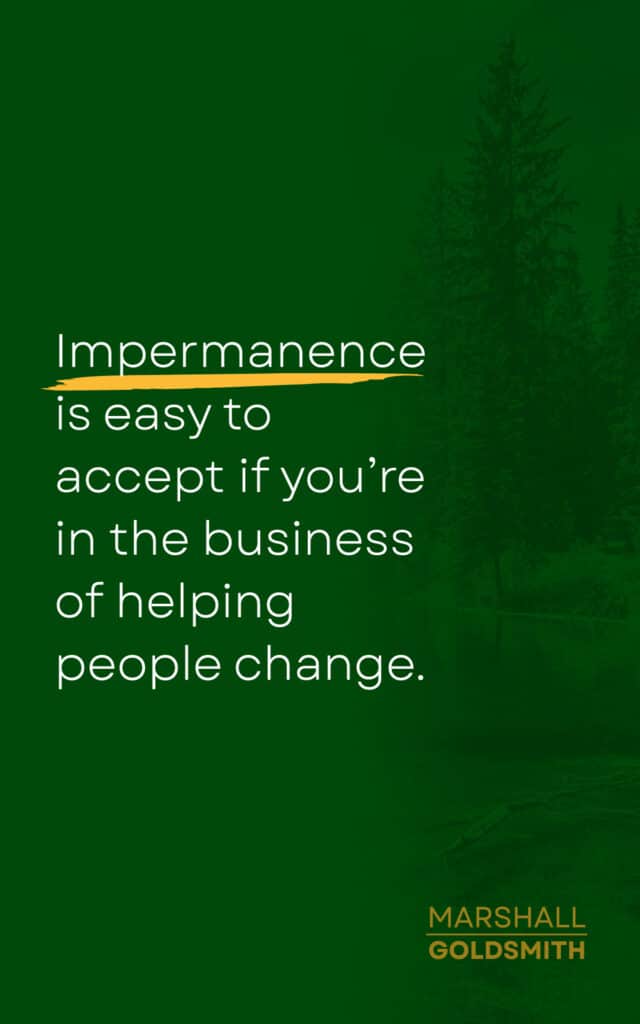Playing Favorites By Marshall Goldsmith There’s a reason I devote...
By Marshall Goldsmith
Giving and receiving feedback has long been considered an essential skill for leaders. People need to know how they are doing, whether or not their performance meets expectations, and how to improve. Traditionally, this information has been communicated in the form of feedback from leaders, who need feedback in the form of suggestions for improvement, innovative ideas for new products and services, and input on their leadership styles.
This information is commonly given in 360-degree feedback, but such feedback focuses on past events – not on the infinite possibilities of the future. Feedback is limited and static, as opposed to expansive and dynamic.
I have observed more than 5,000 leaders as they play two roles. In one, they are asked to provide feedforward – to give someone else suggestions for the future and help as much as they can. In the second role, they are asked to accept feedforward – to listen to suggestions for the future and learn as much as they can. They are not allowed to give feedback about the past.

In this feedforward exercise, people are asked to:
Choose to change one behavior to make a positive difference in their lives.
Describe this behavior to others.
Ask for two suggestions for achieving a positive change in the behavior.
Listen to suggestions and take notes without commenting on them.
Thank others for their suggestions.
Ask others what they would like to change.
Provide feedforward – two suggestions aimed at helping them change.
Say, “You are welcome.” when thanked for the suggestions.
Giving and receiving feedforward only takes about two minutes. When asked to describe this experience, people use words like “great, energizing, useful, helpful, fun.” Few of us think of feedback as fun!
10 Reasons to Try Feedforward
People enjoy receiving feedforward for 10 good reasons:
1. We can change the future, not the past.
Feedforward helps people envision and focus on a positive future, not a failed past. By giving people ideas on how they can be even more successful, we increase their chances of success.
2. It is more productive to help people be right, than prove them wrong.
Negative feedback often becomes an exercise in proving others wrong. This tends to produce defensiveness on the part of the receiver and discomfort on the part of the sender. Even constructive feedback is often seen as negative. Feedforward is positive. It focuses on solutions.
3. Successful people like getting ideas aimed at helping them achieve their goals.
They tend to resist negative judgment, accepting feedback that is consistent with the way they see themselves and rejecting or denying other feedback. They respond to (and even enjoy) feedforward.
4. Feedforward can come from anyone who knows the task, not just the person.
Almost any one can give you ideas on how you can improve. They don’t have to know you. Feedback requires knowing the person. Feedforward just requires having helpful ideas.
5. People do not take feedforward as personally as feedback.
Constructive feedback is supposed to focus on the performance, not the person, and yet most feedback is taken personally.
6. Feedforward assumes that people can make positive changes in the future, whereas feedback tends to reinforce stereotyping, self-fulfilling prophecies, and feelings of failure.
How many of us have been “helped” by a spouse, friend, or colleague who recites our “sins” and shortcomings? Negative feedback reinforces the message, “This is just the way you are.”
7. Most of us hate getting negative feedback, and we don’t like to give it.
Most of us are not very good at giving or receiving negative feedback. Nor do we value the more positive skills of “providing timely feedback” and “encouraging and accepting constructive criticism.”
8. Feedforward can cover most of the same “material” as feedback, but in a more positive manner.
Imagine that you just made a terrible presentation. Using the feedforward approach, your manager helps you prepare for future presentations by giving you very specific suggestions in a positive way, rather than make you “relive” this humiliating experience.
9. Feedforward tends to be more efficient and effective than feedback.
For example, in giving ideas to people, you might say, “Here are four ideas for the future. Please accept them in the positive spirit that they are given. If you can only use two of the ideas, you are still ahead. Just ignore what doesn’t make sense for you.” With this approach, no time is wasted on judging the ideas or proving them wrong.
10. Feedforward can be used with managers, peers, and team members.
Rightly or wrongly, feedback is associated with judgment. This can lead to very negative outcomes. Feedforward does not imply superior judgment. Since it is more focused on being helpful, it is easier to hear. Invite people to ask, “How can I better help our team in the future?” and listen to feedforward from fellow team members.
So, in addition to giving feedback, start giving feedforward and make your life and workplace more enjoyable. By using feedforward, you not only convey the right message, you also ensure that those who receive it are receptive to its content, open to change, and focused on the promise of the future rather than the mistakes of the past.

Adding Too Much Value Won’t Get You There By Marshall...
C-Suite Master Class: No, But, However By Marshall Goldsmith Continuing...
The Doerr Institute: Expanding the Market for Coaches By Marshall...
Making Leadership Development Part of the College Degree at Rice...
Sanyin Siang – Winner of the Thinkers50 Marshall Goldsmith Coaching...
Thinkers50 Marshall Goldsmith Distinguished Achievement Award in Coaching – Nominees...
Leading with Influence: What Is Influence360°? By Marshall Goldsmith Founder...
Are You a Dominator, Manipulator, Persuader or Influencer? By Marshall...
Leading with Influence: Redefining Modern Influence Part 2 By Marshall...

My mission is simple. I want to help successful people achieve positive, lasting change and behavior; for themselves, their people, and their teams. I want to help you make your life a little better. With four decades of experience helping top CEOs and executives overcome limiting beliefs and behaviors to achieve greater success, I don’t do this for fame and accolades. I do this because I love helping people!
As an executive educator and coach, I help people understand how our beliefs and the environments we operate in can trigger negative behaviors. Through simple and practical advice, I help people achieve and sustain positive behavioral change.